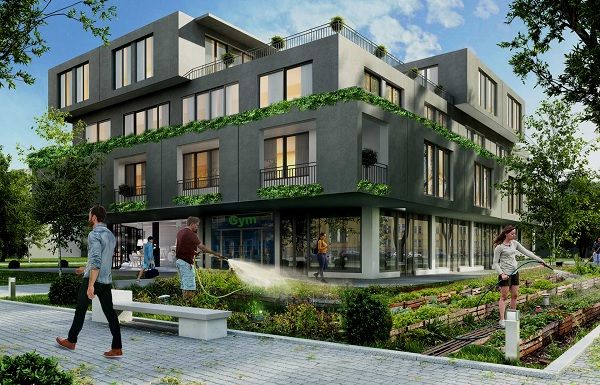We recently conducted a new report with Murmur Research into the future of real estate which features insight from fifteen world-leading business and property experts, and discusses the impact of COVID-19 on office designs and operators, as well as the shift in where and how we want to work.
Our report highlighted that the world over, the buildings we work, live and socialize in are wrestling with the challenge of catering for our new demands and this presents extraordinary opportunities. The office work paradigm in particular was shifting before the pandemic, but this period has propelled us rapidly into a new reality.
The experts we spoke with believe that there have been several key changes to how and where we work that will significantly impact workspaces in the future: there is more of a convergence of home and office life, alongside an increased desire to strike a better work/life balance; there is a heightened demand for neighborhood workspaces that offer excellent amenities without the commute, and an opportunity to socialize; there is already a wholesale change to our business districts; and ultimately there is a new need for flexible office access that you can switch ‘on’ and ‘off’.
The experts all envisaged that the future of work will be characterized by a spectrum of different workspaces co-existing: the central-business-district office, the home office, the suburban co-working hubs, and local high street workspaces.
Philip Harvey, Managing Partner at Property Vision told us that he believes that ‘the choice is no longer home or office – it’s home, vs your neighborhood, vs your office’, while Richard Pickering, Chief Strategy Officer at Cushman & Wakefield said that people will be working from a ‘much more flexible series of interconnected workspaces, to be joined together through technology’.
Some of the experts believed that a private member work space on the high street will have lots of potential too, offering a bolthole close to home for people who want to be surrounded by like minds and relevant resources.
Robbie Kerr, Director at ADAM Architecture told us that he sees home and office work converging more and believes that ‘despite everyone proclaiming home working as the new reality, people will still value the office as a means to get away from the home’.
He envisages a lot of smaller, flexible work spaces springing up, where people can enjoy facilities that aren’t accessible from home, but don’t require long commutes to reach.
The feeling amongst the experts was that it is the hospitality sector, rather than traditional co-working businesses, that has the greatest potential to meet the demand for a ‘third space’ between work and home, where people can socialize, get a change of environment and enjoy artisan coffees and table service.
 Caption: The Third Space – Bars and restaurants adapted to be suitable for working and socialising. Source: Withers
Caption: The Third Space – Bars and restaurants adapted to be suitable for working and socialising. Source: Withers
Longer-term, some experts predicted a more dramatic shift; with more mixed-use spaces where people work, live, earn and socialize in one place.
Jonathan Harbottle, Director & Founder, Land & Partners said: ‘Offices will be repurposed. Since the war the trend has been for single purpose buildings but I envisage lots of office blocks being turned into mixed use ‘vertical villages’ with apartments and work spaces, a deck and food growing all in one building, with management curating and promoting what the building offers and does… cities won’t expand out but up.
Whatever the profile of the landlord or the building, the experts featured in our report believe owners will have to work harder in order to make the asset work for them. This may mean re-purposing space, providing additional flexibility or diversifying the tenant portfolio.
Some of the experts said they wonder whether the era of long lease terms and fixed rents has also had its day. Perhaps the future is more collaborative – and landlords will come to see the relationship with their tenants more as a partnership, where landlords share in the upside during the good times, but shoulder some of the burden during the bad times. This increased risk may deliver heightened rewards for the innovative. Only time will tell.
Withers’ Future of Real Estate Report: Work, Home and Social, can be found at: https://reports.withersworldwide.com/the-future-of-real-estate/cover/.
Jeremy Wakeman is the CEO of the Withers’ Business Division, and a commercial real estate partner. He advises developers, investors and landowners on a broad range of routine as well as complex real estate development issues and transactions. Clients appreciate Jeremy’s commercial and pragmatic approach. Jeremy trained at Withers and became a partner in 2005.
Withers is an international law firm with a broad-ranging client base including multinational corporations, governments, international institutions and individuals and their businesses. It has over 170 partners and more than 450 other lawyers and expertise in commercial, tax, trusts, estate planning, financial services, litigation and international arbitration, public international law, real estate, charities, philanthropy, employment, family law and other legal issues facing individuals and their families. Withers has 17 offices worldwide in London, New York, New Haven, Greenwich (Connecticut), San Francisco, San Diego, Los Angeles, Rancho Santa Fe, Hong Kong, Singapore, Sydney, Tokyo, the British Virgin Islands, Geneva, Milan, Padua and Cambridge. For more, visit withersworldwide.com







